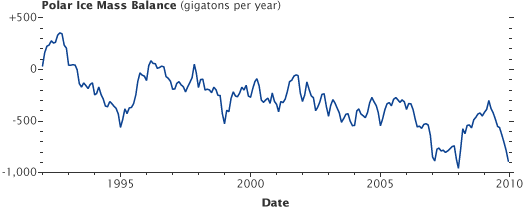Graph of the Day: Polar Ice Mass Balance, 1992-2010
Caption by Mike Carlowicz, with background from Alan Buis
March 26, 2011 According to a new NASA-funded satellite study, the Greenland and Antarctic ice sheets are losing mass at an accelerating pace and are overtaking ice loss from mountain glaciers and ice caps to become the dominant contributor to global sea level rise. The graph above shows the gain and loss of ice mass from the world’s two largest ice sheets. Though there are gains within individual years, the overall trend from 1992 to 2010 has been toward losses. Each year over the course of the 18-year study, the two ice sheets lost a combined average of 36.3 billion tons more than they did the year before. The Greenland ice sheet lost mass faster at an average of 21.9 billion tons more per year. In Antarctica, the year-over-year speedup in lost ice mass averaged 14.5 billion tons. “That ice sheets will dominate future sea level rise is not surprising—they hold a lot more ice mass than mountain glaciers,” said lead author Eric Rignot, jointly of NASA’s Jet Propulsion Laboratory and the University of California, Irvine. “What is surprising is this increased contribution by the ice sheets is already happening. If present trends continue, sea level is likely to be significantly higher than levels projected by the United Nations Intergovernmental Panel on Climate Change in 2007.” …
Astrolabe Glacier and Unbalanced Ice
